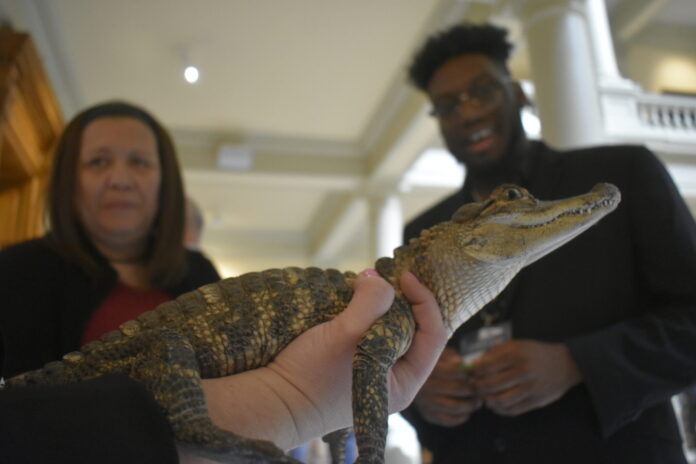
(Georgia Recorder) — Visitors to the state capitol late last week may have spied two alligators at the base of the South Steps.
The gators, named Creature and Charlie, had come a long way from Waycross, Georgia, to join Okefenokee Swamp fans to celebrate Okefenokee Swamp Day and announce a new economic impact study for making the Swamp a UNESCO World Heritage site designation.
“If we want people to protect [the Okefenokee], they need to experience what we are asking them to protect,” Kim Bednarek, executive director of Okefenokee Swamp Park, said at the Capitol. “We are providing those experiences and trying to heighten the visibility of the Okefenokee so that people around the country want to protect the Okefenokee and get excited about it.”
Tourism operators like the Okefenokee Swamp Park are taking full advantage of the Okefenokee National Wildlife Refuge’s natural wonder.
But at the state level, the battle for House Bill 71, the Okefenokee Protection Act spearheaded by GOP state Rep. Darlene Taylor, rages on as Alabama-based company Twins Pines Minerals plans to dig for titanium in a 582-acre area near the swamp, sparking public outcry since the Alabama company unveiled plans in 2019.
“There’s a very good reason for the Natural Resources Committee to hear this bill again this year, to vote on it and to move it forward,” Michael O’Reilly, director of government relations at The Nature Conservancy, said. He pointed to the U.S. government’s consideration of nominating the Okefenokee National Wildlife Refuge as a world heritage site with support from Georgia’s congressional delegation.
Late Friday afternoon, the state Environmental Protection Division announced its decision to issue draft permits to Twin Pines, triggering a 60-day public comment period, where people can send in written comments to [email protected] before a virtual meeting on March 5 at 6 p.m.
The bill, which would block new or expanded mining proposals, is currently in its third year before the Legislature. Last year, it successfully earned a hearing in the House of Natural Resources and Environment Committee, but that hearing was held after the deadline for bills to move forward from one chamber to another. Despite garnering over 90 signatures from lawmakers on both sides of the aisle – representing more than enough votes to clear the chamber – the Okefenokee Protection Act was never put to a vote in the committee by Chair and Newnan Republican Rep. Lynn Smith and got kicked to this year’s legislative session.
“I’m hopeful that committee chair Smith will see this opportunity to bring a bill for a vote in the committee soon,” O’Reilly added.
Rena Ann Peck, executive director of the nonprofit Georgia River Network, said the bill creates reasonable restrictions that protect the swamp.
“I don’t think that right now, the chair of the House Natural Resources Environment Committee plans to bring it to a vote,” Peck said. “She believes that retiring (the) ability to mine on Trail Ridge is a taking, but it’s not.”
Peck said that the Okefenokee is a “globally recognized jewel” with multiple values to offer and does not qualify as a taking, which is when the government restricts the use of a property without fairly compensating the owner, as is sometimes the case with highway building.
State Rep. Darlene Taylor, a Thomasville Republican who sponsored HB71, said the Okefenokee is a unique place that deserves protection.
“There’s not another one like it,” Taylor said. “It’s got a lot of natural habitat. It is the controlling part of the ecosystem in Southeast Georgia and Northeast Florida, so it’s going to affect the water systems in that area. Like everybody else, I want it to be protected.”
Twin Pines is a powerful force to fight against in the Legislature, with $180,000 spent on Georgia lobbying in 2023, according to OpenSecrets. Supporters of the mining proposal include the Charlton County Commission, which passed a resolution to support the proposed strip mine near the Okefenokee in 2019, citing economic benefits to the region, such as jobs and tax revenue.
“If [Twin Pines] can get their permits, then they’re supportive. If they cannot get their permits through the issuing authority, then they don’t want it,” Charlton County administrator Hampton Raulerson said, saying the mining would increase the number of decent paying jobs in the region as an existing mining operation on the northern end of the county is set to leave Charlton next year.
Steve Ingle, president of Twin Pines, said in a statement that mining would invest up to $300 million in the area and that yearly taxes would nearly double Charlton County tax digest, adding, “It will provide hundreds of good-paying jobs in an area where there are many people in need of employment and we’re ready to put them to work.”
Environmentalists and members of the public say they are determined to fight back against the mining.
“This mine is a direct attack on a vital area of the state,” environmental lobbyist Neill Herring said, citing public outrage and local governments in the Okefenokee region’s opposition to the mining.
“Environmental groups in Georgia are determined to protect the Okefenokee Swamp from unwelcome intrusion into the operation of the natural systems, the natural ecology of the swamp in its entirety,” Herring said. “We will spare no effort in challenging any permit issued to any miner who threatens the integrity of the Okefenokee Wildlife Refuge.”
As this year’s crossover day looms February 29, the next step for the Okefenokee’s fate will come at the EPD public hearing.
“At this point, it’s really important that Georgians make their feelings known and submit comments by the deadline and also voice their complaints in the hearing that is scheduled for March 5,” Southern Environmental Law Center Senior Attorney Bill Sapp said. He urges Georgians to register for the hearing on the EPD website and tell their friends and family to do the same.
He can count on support from the St. Mary’s Riverkeeper, which advocates for clean water in the southeast corner of Georgia.
“We really want to highlight that it is a wetland and that it does have value not only to the environment and to our overall health, but as a recreational opportunity as well,” Emily Floore, executive director of the St. Mary’s Riverkeeper nonprofit, said. “It provides a green space for people to be able to experience nature as it was. There’s very few places we have nowadays where you can go to the outdoors and see something that is pretty much intact.”







